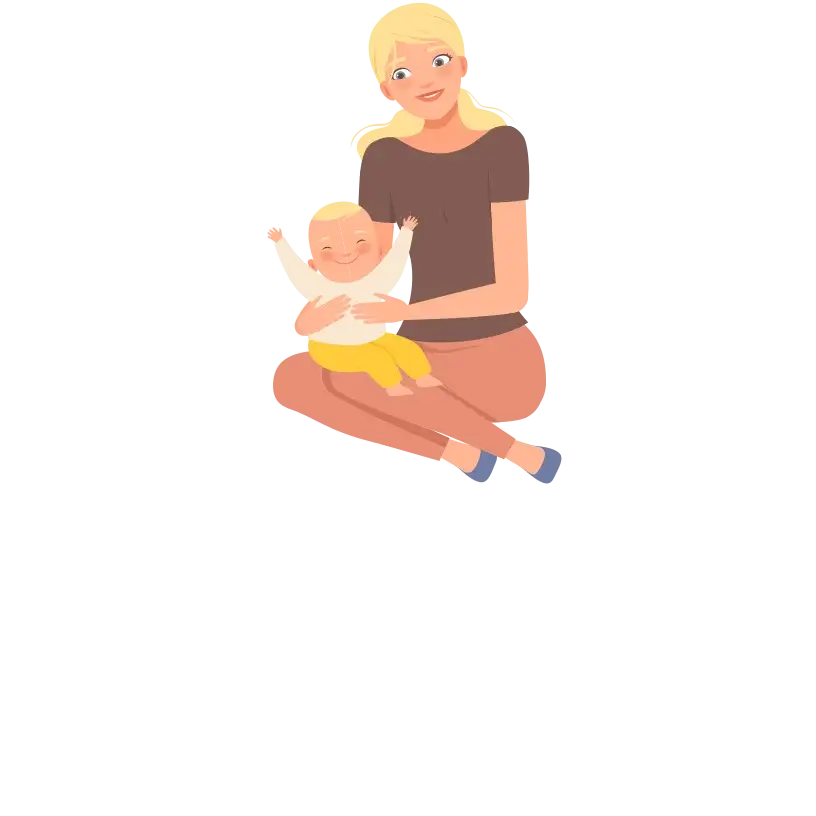Menu

At 4-month-old, your baby’s focus shifts towards playtime, marked by laughter, reaching, and increased gnawing. As you engage in floor play, you’ll observe emerging athletic abilities like rolling and pushing up. Consider incorporating your baby’s activities into your routine as physical activity.
During this phase, your child displays interest in interactive play, potentially signalling the onset of teething. Common questions at this stage include considerations about giving water to your 4-month-old, introducing real food, and the inevitability of sleep regression. Understanding these aspects provides a foundation for navigating your growing child’s evolving needs and milestones.
As your baby reaches four months, you might notice a semblance of routine settling into your daily life. Although the pace may feel less hectic, your little one is likely keeping you engaged with their developing motor skills. Over the coming months, they’ll refine their abilities, progressing from grasping objects to confidently rolling over and eventually sitting up independently.
At 4-month-old, your baby likely grows rapidly, averaging around 1 to 1¼ pounds per month. Notably, a consistent growth rate holds greater significance than specific gains in weight or height.
On average, girls at four months old typically weigh approximately around 14 pounds 2 ounces and 24 1/2 inches. Meanwhile, boys of the same age tend to be a bit larger, weighing 15 pounds 7 ounces and measuring about 25 1/4 inches.
It’s perfectly normal if your baby falls outside these averages, as babies, like adults, exhibit significant variations in height and weight.
At approximately 4 months old, your baby likely feeds less frequently compared to earlier months. This change is due to the growth of their stomach, enabling them to take in more nourishment during each feeding.
However, your 4-month-old is likely feeding less often due to a larger stomach; they still require regular nourishment, typically every four hours. Breastfed babies may need more frequent feedings, possibly every three hours, as they can get hungry sooner.
This is normal; the key is to feed your baby until they appear satisfied. For formula-fed babies, providing around 6 ounces every three or five hours is generally sufficient for their nutritional needs.
To ensure your baby gets enough food, watch out for their wet diapers; your baby should have at least six wet diapers daily. If you notice issues like clicking sounds while sucking, breathing difficulties, or frequent spitting up, reach out to your pediatrician promptly for guidance and support. Early communication helps address potential feeding or health concerns.
Introducing solid food to your baby marks a significant developmental milestone. Before embarking on this journey, gathering the necessary information is essential to ensure a smooth transition. For your newborn, breast milk or formula provides all the essential nourishment they require.
The American Academy of Pediatrics advises exclusive breastfeeding for the initial six months after birth.
Many babies reach a stage between the ages of 4 and 6 months when they are ready to incorporate solid foods alongside breast milk or formula. During this transition, babies typically develop the coordination needed to move solid food from the front of their mouths to the back, facilitating swallowing.
It’s when they begin to outgrow the reflex of pushing food out with their tongues, signaling their readiness to introduce complementary solid foods to their diet.
The American Academy of Pediatrics (AAP) suggests several signs that indicate your baby may be ready to begin solid foods:
Note: The American Academy of Pediatrics (AAP) advises exclusively breastfeeding your baby for the first approximately six months after birth. Following this period, the AAP supports the continuation of breastfeeding and the introduction of complementary foods.
It’s recommended to continue breastfeeding for as long as both you and your child desire, ideally for at least two years or beyond.
Consulting with your child’s doctor is crucial, especially regarding recommendations for vitamin D and iron supplements during the first year. This ensures your child receives appropriate nutrition and supports healthy development throughout their early years.
Your baby’s sleep pattern typically shows more regularity at four months old. Many infants begin to establish a more defined sleep routine, with longer periods of nighttime sleep.
It’s common for a 4-month-old to sleep consecutively at night for seven to eight hours, indicating a transition toward longer periods of nighttime rest. This can offer parents a more extended stretch of uninterrupted sleep.
On average, a 4-month-old baby accumulates approximately 10 hours of sleep at night, often with a notable wake-up for feeding or a diaper change. Additionally, they tend to nap for an additional four to five hours during the day, typically in the form of two naps—one in the morning and one in the afternoon.
In general, a 4-month-old’s daily sleep duration ranges from 12- 16 hours.
It’s important to note that individual babies may deviate from these general patterns. If your baby’s sleep differs from these averages, it’s normal, and parents should focus on meeting their baby’s unique needs.
Creating a soothing sleep environment, using white noise machines, and ensuring optimal room temperature and clothing comfort can contribute to a more restful sleep routine for your 4-month-old.
It is common for your little one to experience sleep regression around this age. This is because, at around four months, your baby becomes more active and undergoes significant adjustments, including adapting to a new sleep cycle.
As a result, you might notice changes in your baby’s sleep patterns, such as increased night waking, difficulties in falling asleep, or shorter naps.
Sleep regression occurs when a baby or toddler who has been sleeping well suddenly experiences sleeping difficulties. During sleep regression, your child may have trouble falling, staying, or maintaining their usual sleep schedule. Increased nighttime waking, shorter naps, or general restlessness during sleep can characterize this.
Research has shown that sleep regressions may happen alongside the developmental brain changes that happen roughly between 2 and 21 months of age.
Around four months, babies often experience changes in sleep patterns due to developmental milestones. Here are some tips to assist you during this phase:
When your baby was born, they could only sense basic things. But now, as they’ve grown, their senses have gotten much better. Your little one is more awake and aware of what’s happening around them.

Your baby’s vision has progressed, and they can now focus more clearly on objects. High-contrast patterns, bright colours, and moving objects may capture their attention.

Auditory skills have improved, and your baby can recognize and respond to various sounds. They may turn towards familiar voices and react to music or gentle noises.

Tactile sensitivity is developing, and your little one is likely more responsive to different textures. They may express preferences through touch, enjoying the feel of soft fabrics or exploring surfaces with their hands.

While your baby’s primary source of nutrition is still breast milk or formula, they may begin to show early signs of interest in tasting new textures as they explore the world around them.

Your baby’s sense of smell is evolving. They may show preferences by turning towards pleasant scents and away from unpleasant ones. This early sensitivity is a step in their ability to recognize and understand different odors.

Your baby’s vision has progressed, and they can now focus more clearly on objects. High-contrast patterns, bright colours, and moving objects may capture their attention.

Auditory skills have improved, and your baby can recognize and respond to various sounds. They may turn towards familiar voices and react to music or gentle noises.

Tactile sensitivity is developing, and your little one is likely more responsive to different textures. They may express preferences through touch, enjoying the feel of soft fabrics or exploring surfaces with their hands.

While your baby’s primary source of nutrition is still breast milk or formula, they may begin to show early signs of interest in tasting new textures as they explore the world around them.

Your baby’s sense of smell is evolving. They may show preferences by turning towards pleasant scents and away from unpleasant ones. This early sensitivity is a step in their ability to recognize and understand different odors.
Inconsolable Crying: Crying is your baby’s way of communicating distress or discomfort. Persistent or intensified crying, especially if it’s different from their usual patterns, could indicate various forms of discomfort, such as hunger, fatigue, or physical discomfort like a wet diaper.
Changes in Facial Expressions: The face is a powerful communicator of emotions. Scrunching of the face, furrowed brows, or a distressed expression can suggest discomfort. Your baby may react to something in their environment or experience physical discomfort.
Restlessness: Restlessness, characterized by squirming, fidgeting, or difficulty settling, is a common response to discomfort. Your baby may be trying to find a more comfortable position or signalling something is bothering them.
Changes in Sleeping Patterns: Discomfort can significantly impact your baby’s sleep. Increased restlessness, frequent waking, or difficulty falling asleep may indicate your baby is in discomfort. It could be related to physical discomfort or changes in their sleep environment.
Fussiness During Feeding: Feeding is a crucial time for comfort and nourishment. If your baby becomes irritable, refuses to feed, or displays frustration during feeding, it may suggest discomfort. Possible causes include reflux, teething discomfort, or a need for a different feeding position.
Body Language: Your baby’s body language is valuable for communication. Arching their back or clenching fists might signal discomfort. This could be in response to physical discomfort, such as gas or reflux, or a way of expressing frustration.
Gastrointestinal Signs: Gastrointestinal discomfort can manifest as an unsettled stomach, excessive gas, or changes in bowel movements. These signs could indicate issues like colic, constipation, or sensitivity to certain foods.
Your baby becomes more social and loves making cute babbling sounds at four months old. They enjoy experimenting with different noises, showing how they’re discovering the joy of communication and interaction.

Your baby is learning to sit with support, showcasing improved neck and upper body strength. This is a crucial step toward developing the muscles needed for independent sitting.

As your baby’s social awareness grows, they start expressing joy through laughter and giggles. This milestone reflects their developing emotional connection and enjoyment.

Babbling marks the beginning of your baby’s communication skills. They experiment with various sounds, laying the groundwork for language development and interaction.

Teething is the process of your baby’s first teeth emerging. It can lead to increased drooling, chewing on objects, and sometimes mild discomfort. Providing teething toys can offer relief.

Your baby is discovering their body by grabbing and exploring their toes. This milestone signifies the development of hand-eye coordination and body awareness.

Your baby’s ability to intentionally grasp objects is improving. This fine motor skill development is a significant step toward interacting with toys and the environment.

Rolling over marks a major motor milestone. Your baby is gaining control over their body movements, transitioning from back to tummy or vice versa, showcasing increased strength and coordination.

As your baby’s muscles strengthen, tummy time becomes more enjoyable. Your baby may lift their head, push up on their arms, and explore their surroundings, contributing to overall physical development.3

Your baby is developing hand-eye coordination and fine motor skills, allowing them to reach for objects intentionally using one hand. This milestone showcases their growing ability to interact with and explore their surroundings.

This indicates your baby’s awareness of objects in their environment. They attempt to engage with dangling toys by swatting or swinging at them. This developmental step demonstrates their improving motor skills and visual-motor coordination as they reach out to interact with objects of interest.

Your baby is learning to sit with support, showcasing improved neck and upper body strength. This is a crucial step toward developing the muscles needed for independent sitting.

As your baby’s social awareness grows, they start expressing joy through laughter and giggles. This milestone reflects their developing emotional connection and enjoyment.

Babbling marks the beginning of your baby’s communication skills. They experiment with various sounds, laying the groundwork for language development and interaction.

Teething is the process of your baby’s first teeth emerging. It can lead to increased drooling, chewing on objects, and sometimes mild discomfort. Providing teething toys can offer relief.

Your baby is discovering their body by grabbing and exploring their toes. This milestone signifies the development of hand-eye coordination and body awareness.

Your baby’s ability to intentionally grasp objects is improving. This fine motor skill development is a significant step toward interacting with toys and the environment.

Rolling over marks a major motor milestone. Your baby is gaining control over their body movements, transitioning from back to tummy or vice versa, showcasing increased strength and coordination.

As your baby’s muscles strengthen, tummy time becomes more enjoyable. Your baby may lift their head, push up on their arms, and explore their surroundings, contributing to overall physical development.

Your baby is developing hand-eye coordination and fine motor skills, allowing them to reach for objects intentionally using one hand. This milestone showcases their growing ability to interact with and explore their surroundings.

This indicates your baby’s awareness of objects in their environment. They attempt to engage with dangling toys by swatting or swinging at them. This developmental step demonstrates their improving motor skills and visual-motor coordination as they reach out to interact with objects of interest.
Engaging activities for a 4-month-old are designed to stimulate their developing senses and motor skills. These may include:
Tummy Time: Encourage your little one to spend short, supervised moments on their tummy. This helps build their neck and upper body muscles, setting the stage for future milestones like crawling.
High-Contrast Toys: Introduce toys with bold patterns and vibrant colours. Your baby’s developing vision will love these stimulating toys, which will enhance their visual focus and recognition.
Soft Textures: Let your baby explore soft textures using gentle toys or fabrics. This tactile experience helps them become familiar with different sensations, fostering their sense of touch.
Talking and Singing: Engage in heartwarming conversations and soothing singing with your little one. Beyond fostering language development, these moments create a special bond between you and your baby.
Mirror Play: Place a baby-safe mirror before your little one for delightful self-discovery. This captivates their attention and introduces the concept of recognizing themselves.
Soft Rattles: Offer soft rattles or toys that produce gentle sounds. Your baby will enjoy exploring these auditory sensations, associating sounds with playful moments.
Reading Time: Enjoy reading colourful board books with your baby. This will introduce them to the world of books and provide a cosy time for you both to connect.
Gentle Swinging: Offer a soothing experience, whether in a cozy baby swing or while holding your baby in your arms. The rhythmic motion helps calm your baby and creates a feeling of security by mimicking the comforting sensations they felt in the womb. It can also help your baby relax and settle, making it easier for them to sleep or simply enjoy a peaceful moment.
Before introducing water, it’s generally advised to wait until your baby is six months old. At four months, exclusive breastfeeding or formula provides your baby with the necessary hydration and nutrients. Introducing water too early might compromise their intake of essential nutrients.
It’s generally advised to refrain from giving your 4-month-old solid food. The recommended practice is exclusively providing breast milk or formula until six months. Although, you might observe signs such as diminished tongue-thrust reflex, independent head control, and an interest in the foods you’re eating, indicating your baby may be ready for the introduction of solid foods.
Your baby might start bearing some weight on their legs at 4 months, allowing brief moments of being upright. However, it’s important not to push them to stay on their feet for too long, only keeping them upright until they seem comfortable. Typically, most babies can fully bear weight on their legs by about 7 to 8 months.
At four months old, limiting or avoiding screen time, including television, is generally recommended for babies. The American Academy of Pediatrics suggests waiting until at least 18 months before introducing any screen media, except for video chatting. This is because very young babies learn best from face-to-face interactions, and excessive screen time may interfere with their development.
Sleep regression can vary in duration, typically lasting between 2 to 6 weeks. It often occurs around specific ages, such as four months, six months, eight months, 12 months, 18 months, and two years. During these periods, babies may experience disruptions in their sleep patterns, which can be attributed to various developmental changes. Patience and consistency in your baby’s sleep routine can help you navigate these phases.
Before introducing water, it’s generally advised to wait until your baby is six months old. At four months, exclusive breastfeeding or formula provides your baby with the necessary hydration and nutrients. Introducing water too early might compromise their intake of essential nutrients.
It’s generally advised to refrain from giving your 4-month-old solid food. The recommended practice is exclusively providing breast milk or formula until six months. Although, you might observe signs such as diminished tongue-thrust reflex, independent head control, and an interest in the foods you’re eating, indicating your baby may be ready for the introduction of solid foods.
Your baby might start bearing some weight on their legs at 4 months, allowing brief moments of being upright. However, it’s important not to push them to stay on their feet for too long, only keeping them upright until they seem comfortable. Typically, most babies can fully bear weight on their legs by about 7 to 8 months.
At four months old, limiting or avoiding screen time, including television, is generally recommended for babies. The American Academy of Pediatrics suggests waiting until at least 18 months before introducing any screen media, except for video chatting. This is because very young babies learn best from face-to-face interactions, and excessive screen time may interfere with their development.
Sleep regression can vary in duration, typically lasting between 2 to 6 weeks. It often occurs around specific ages, such as four months, six months, eight months, 12 months, 18 months, and two years. During these periods, babies may experience disruptions in their sleep patterns, which can be attributed to various developmental changes. Patience and consistency in your baby’s sleep routine can help you navigate these phases.
1. American Academy of Pediatrics: Starting Solid Foods.
2. Center for Disease Control and Prevention: Data Table of Infant Weight-for-age Charts.
3. Center for Disease Control and Prevention: Data Table of Infant Length-for-age Charts
4. Healthy Children: How Often and How Much Should Your Baby Eat?
5. Kids Health: Sleep and Your 4- to 7-Month-Old
6. Mayo Clinic: Infant and toddler health
7. Nemours Kids Health: Your Baby’s Growth: 4 Months
8. News Today: What are the stages of sleep regression
© Mindsmaking 2024